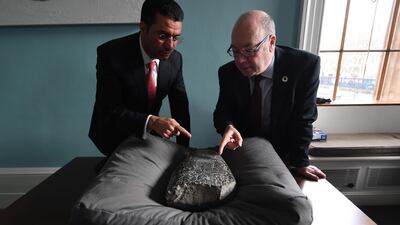A valuable Babylonian cuneiform stone was handed back to Iraq by the British government on Tuesday, after an attempt to smuggle it into the country was foiled at Heathrow airport.
Dating from the second millennium BC, the antiquity is worthy of the world’s greatest museums and valued at hundreds of thousands of pounds.
The object will be formally handed over by the UK government to the Iraqi embassy during a ceremony held at the British Museum.
“This is a great example of cultural diplomacy in action and demonstrates positive UK-Iraqi relations,” Michael Ellis, Minister for Arts, Heritage and Tourism, said. “We are committed to protecting and preserving cultural heritage, both in the UK and across the world, and I am delighted that this important artefact is being returned.”
UK Border Force seized the object at London's Heathrow airport in 2012 and it was later identified at the British Museum as one of the few surviving examples of a Babylonian kudurru, an official document drawn up on the instructions of a Babylonian king to record the gift of lands or other benefits bestowed on a named individual who has rendered particular service to the crown.
Fewer of 200 examples of this type of Babylonian inscribed stone are estimated to exist today. Almost all of them come from the territory of Iraq.
Many archaeological sites in southern Iraq were badly looted between 1994 and 2004 and this artefact was most likely found during this phase of illicit activity, according to an assessment by the museum.
Alistair Burt, Minister of the Middle East and North Africa said he "witnessed the extraordinary strides Iraq has made since the fall of Daesh [ISIS]." "Today's repatriation, in conjunction with the British Museum, is just one example of the UK's ongoing commitment to helping Iraq create for itself prosperous and secure future following the fall of Daesh," he added.
Salih Husain Ali, Ambassador of the Republic of Iraq to the UK, said “it is very important for Iraq to regain ownership of its looted artefacts which are part of our country and nation’s rich culture. We are grateful to the British authorities and in particular to the British Museum for the extraordinary efforts in identifying and returning this invaluable piece of Iraq’s heritage.”
While the description has been lost to the damage suffered to the lower part of the kudurru, the text is thought to have been a summary of the historical background to the royal gift. Next came a description of the gift, in this case a grant of land. A list of witnesses to the gift is followed by a series of protective curses threatening anyone who might dispute the gift or damage the kudurru. It is likely to have been placed in a temple, but it is uncertain which one.
The smuggler had tried to take it into the UK claiming it was a “carved stone for home decoration.”

